Stuff in the Sky
Steven Dutch, Professor Emeritus, Natural and Applied Sciences, University of Wisconsin - Green Bay
Scattering
Scattering is the process of light bouncing off small particles. There are many kinds of scattering. However, short wavelengths of light (blue) are more effectively scattered because long wavelengths simply pass over particles the same way large ocean waves ignore pebbles.
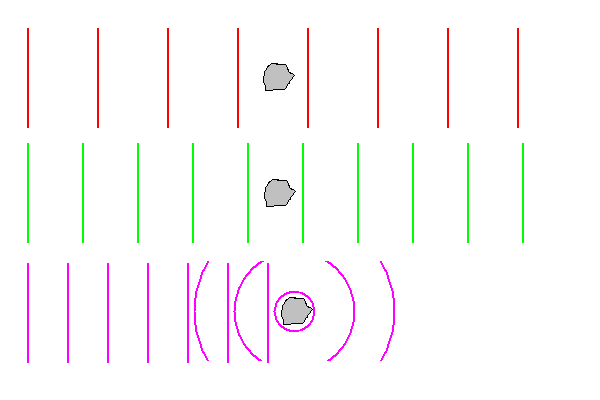
Why the Sky is Blue
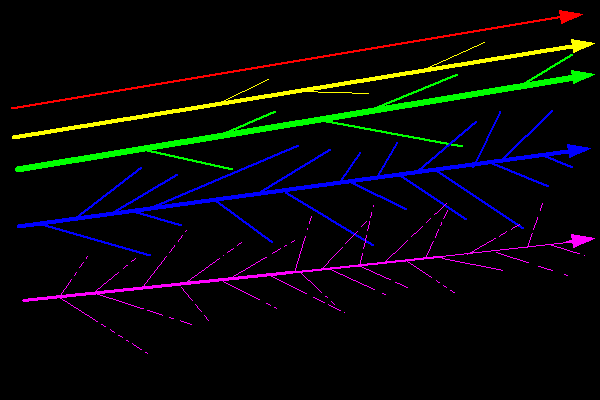
This turns out to be an amazingly complex problem. If short wavelengths of light are scattered more than long wavelengths, then violet light should be scattered most of all, so why isn't the sky violet?
The answer depends on many factors. First, the sun emits the largest amount of light in the green part of the spectrum. There is less blue light than green and less violet light than blue. Second, our eyes have evolved to see the light emitted by the sun, so our eyes are most sensitive in the green part of the spectrum rather than to blue and violet. So we see blue better than violet, and there's more of it to see.
Next, scattering increases toward the violet end of the spectrum, so even though there's more green light in sunlight, less of it gets scattered from the open sky. Violet light gets scattered the most, but it also gets absorbed the most, so some of it never reaches our eyes.
Finally, there's the way our eyes respond to mixtures of colors. Sunlight is strongest in the green part of the spectrum, but we don't see the sun as green. We see that mixture of colors as white with a hint of yellow. If we illuminate something with a mix of green, blue and violet light, our brains will process that mix as blue.
On the average, a photon of light from blue sky has been scattered just once. If particles are numerous, however, the light may be scattered many times, a phenomenon called multiple scattering.
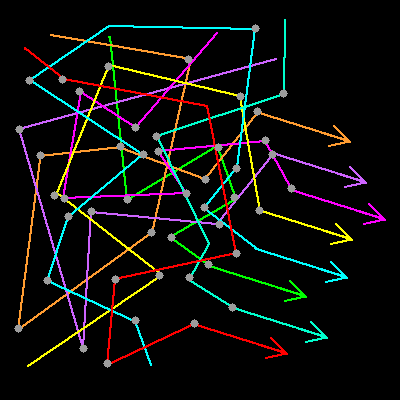
| When light has undergone multiple scattering, our eyes get a random mixture of colors from all over, and we see white light. Virtually everything that is white owes its color to multiple scattering: clouds, snow, paper, sugar, salt, beach sand, milk, white paint. |  |
 |
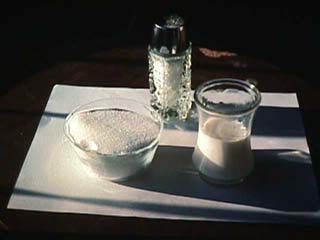 |
Also, since light is scattered so much, the chances of a photon making it all the way through in a straight line are very small. Small amounts of multiple scattering, as in thin fog, wash out colors and reduce visibility of distant objects. Larger amounts of multiple scattering, as in thick clouds, make the object completely opaque. This is why clouds look dark when they are not sunlit. In the photo at lower right above, even though the salt, sugar and milk are made entirely of substances that are intrinsically transparent, they all cast distinct shadows because scattering prevents light from getting through.
Side comment: one material that is very good at scattering light is titanium dioxide. It is a principal ingredient in white paint. Surprisingly, it's also an ingredient in black ink, because any light that gets through the ink is scattered by the titanium dioxide. It helps make the ink opaque.
The Setting Sun
Red Sun
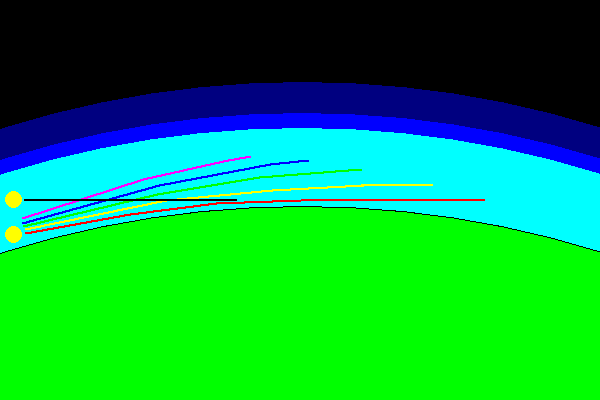
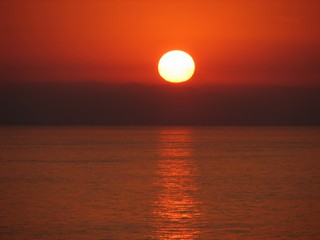 |
When the sun is setting, it looks red because it is traveling through a long distance of air, and all the shorter wavelengths of light are absorbed or scattered before they reach your eye. The atmosphere also bends or refracts light, so much so that when the setting sun appears to be on the horizon, it has actually set. This effect is greatest the closer the sun is to the horizon, so that the setting sun appears flattened because light from the bottom of the sun is refracted more than light from the top. |
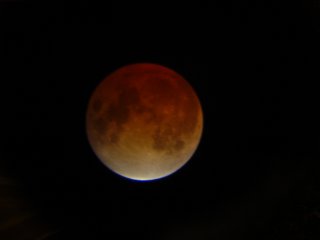 |
The fact that sunlight is reddened and refracted by the earth's atmosphere means that during an eclipse of the moon, reddened sunlight refracted through the earth's atmosphere still strikes the moon. |
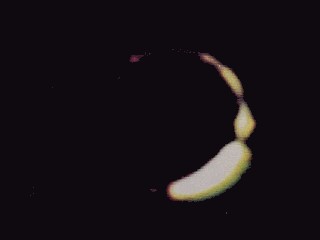 |
This astonishing picture, surprisingly, is rarely seen. Taken in 1966 by one of the Surveyor lunar landers, it was for many years the only picture ever taken of a lunar eclipse as seen from the Moon. The Earth is totally eclipsing the sun, but sunlight scattered by the Earth's atmosphere creates a bright ring around the Earth. |
The Green Flash
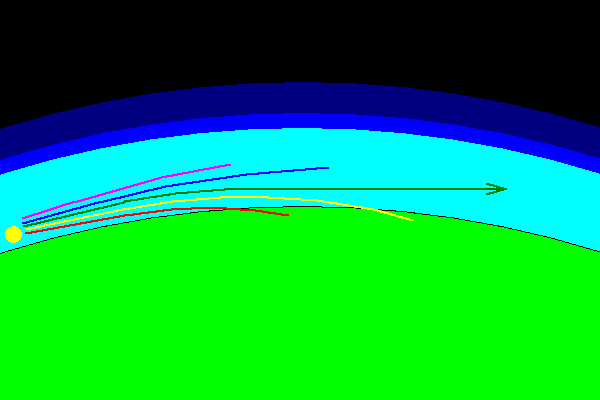
Not the latest comic book (sorry, graphic novel) super-hero, and not an urban legend as some people claim. It's real. The atmosphere bends different wavelengths differently, just like a prism. This effect is called dispersion. If you look at a very bright star just above the horizon with binoculars, you may see it flicker with different colors because of dispersion.
If the sky is extremely clear at sunset, then the refraction of sunlight may bend red and yellow light into the ground before it gets to your eye, while blue and violet light are scattered or absorbed before they reach you. The last pinpoint of the setting sun may appear green for a second or two.
This is rarely seen because it's rare for the horizon to be that clear and unobstructed. You need a very flat horizon, otherwise the sun won't be low enough for dispersion to be effective. A sea horizon would be best, but even on very clear days at sea there is enough haze on the horizon to redden the sun too much. The green flash is often seen in the Arctic and Antarctic because the cold air is very dry and because the sun sets at a grazing angle to the horizon, making the effect last longer. (Around here, try northern Door County after the Bay is frozen.)
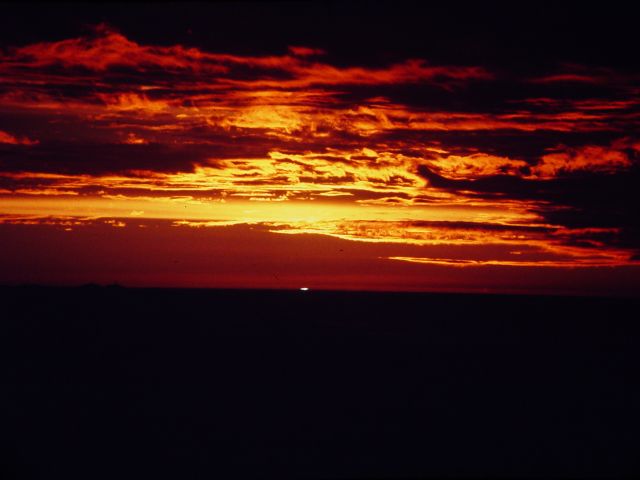
The green flash above actually appeared as a bright blue-white star on the horizon for a few seconds. Blue is even less common than green and requires extremely clear air. (Small consolation if you want to see green! The sky is blue.) This picture was taken at Palmer Station, Antarctica.
The Earth's Shadow
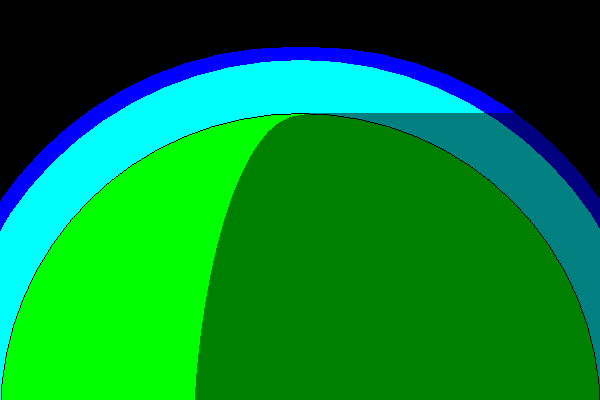
After the sun has set, the sky overhead still looks blue because it is still sunlit and still scattering sunlight. But in the east, the atmosphere is no longer illuminated by the sun. We see the boundary as a rather sharp line between light illuminated sky and dark blue sky. This boundary, which is actually the shadow of the earth cast on the atmosphere, is sometimes called the Girdle of Venus.
 |
The earth's shadow is seen here as a blue band grading sharply into pink. Note that the full moon is very close to the boundary, hence exactly opposite the Sun. So it should be no surprise that there was an eclipse of the moon a few hours later. |
 |
From an airliner, the earth's shadow can be seen sloping down toward the sun. The curvature of the earth's horizon is just barely visible from an airliner at 10 kilometers altitude. |
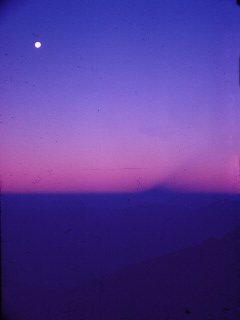 |
On high mountain peaks, not only is the earth's shadow visible, but the shadow of the mountain itself. |
Crepuscular Rays
"Crepuscular" actually means "pertaining to twilight." I heard a talk on mountain lions once that described them as crepuscular. Fortunately, just because you see crepuscular rays doesn't mean there's a mountain lion lurking nearby. Usually. These rays are most dramatic near sunrise or sunset, hence the name.
These wonderfully picturesque rays are due to scattering. Dust or water droplets in the air are illuminated by the sun and scatter sunlight while shadowed areas do not. Light also scatters through the thin edges of clouds, making them bright white, while the same scattering prevents light from penetrating through the thick parts of the clouds, leaving them darkly silhouetted.
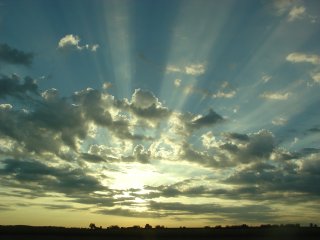 |
The rays are actually parallel but appear to radiate away from the sun because of perspective. |
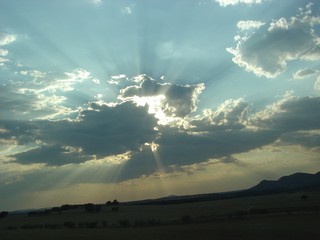 |
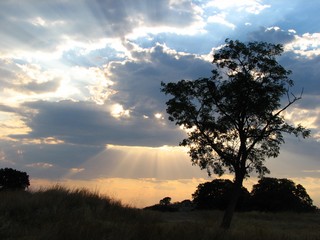 |
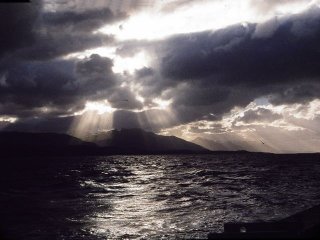 |
Crepuscular rays over water are sometimes said to be the sun drawing water up into the clouds. Nonsense. |
Anti-Crepuscular Rays
Now here's some nicely confused terminology. Strictly speaking, anti-crepuscular should mean the opposite of twilight - in other words, rays you see at noon. However, you can only see these from the ground when the anti-solar point is close to the horizon, that is, near sunrise or sunset. Under the right conditions, you can see them from an airplane any time of day.
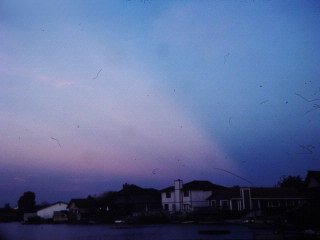 |
Actually, these are crepuscular rays that cross the entire sky to converge on the opposite horizon. Again, the rays are parellel and the convergence is a perspective effect. Shadows can penetrate hundreds of miles across the atmosphere, so these rays can be created by clouds or distant mountains far beyond the horizon, up to hundreds of kilometers away. They can occur in a completely cloudless sky. |
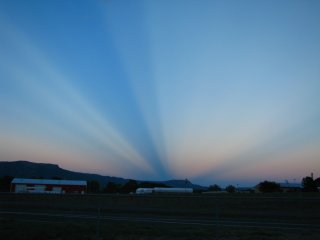 |
A spectacular set of anti-crepuscular rays. |
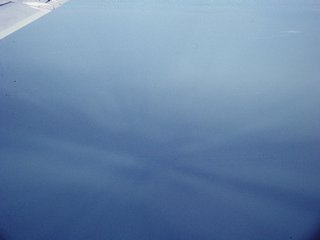 |
Anti-crepuscular rays seen from an airplane looking down into a hazy sky. |
Rainbows
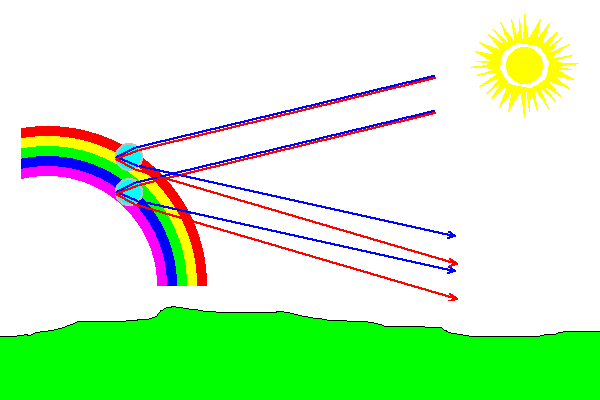
The poet Keats once lamented that science had explained the rainbow and robbed it of its mystery:
There was an awful rainbow once in heaven:
We know her woof, her texture; she is given
In the dull catalogue of common things.
Philosophy will clip an angel's wings. (Lamia. Part ii)
As a scientist, I can look at a rainbow and see all the beauty that Keats saw, plus I can see things he could not. For one thing, every single rainbow is unique and no two people ever see exactly the same rainbow. For that matter, you never see the exact same rainbow for more than a split second.
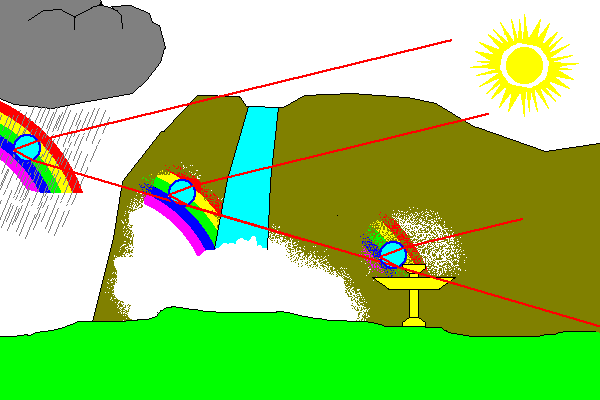
The only thing that matters with a rainbow is the angle between the sun, the drop and your eye. Distance doesn't enter into it at all. So it's possible to see a continuous rainbow formed by droplets from a distant rainstorm, a nearer waterfall, and a nearby fountain.
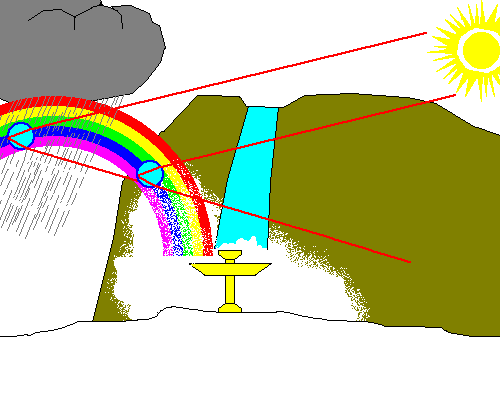
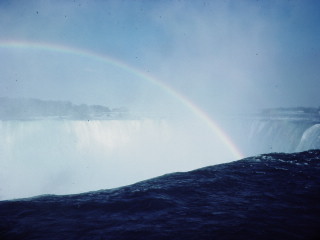 |
Rainbow over Niagara Falls |
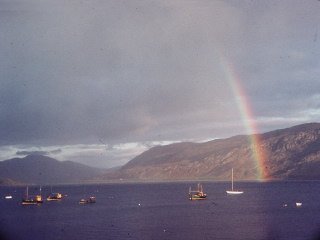 |
Even though a rainbow isn't a real physical object, this one can be seen faintly reflected in the water. The explanation is below. |
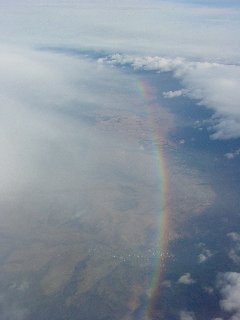 |
In theory a rainbow should make a complete circle. Inverted bows are rarely seen from commercial airliners. To see one, you'd have to be flying through sunlit rain. Here a rain shower is illuminated just right to see that the rainbow also has a lower half. |
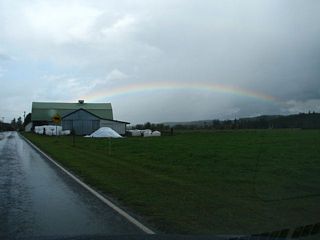 |
When the sun is high in the sky, rainbows are low. If the sun is higher than 42 degrees, the rainbow is below the horizon. |
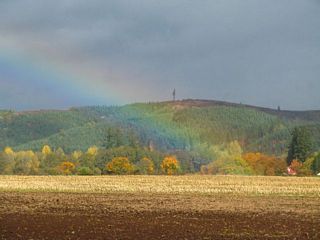 |
The drops can be any distance away and it is common to see rainbows in front of distant objects. The whole pot of gold business is a reflection of the fact that the rainbow is a purely optical effect and has no real physical location. So you can never get to the end of one. |
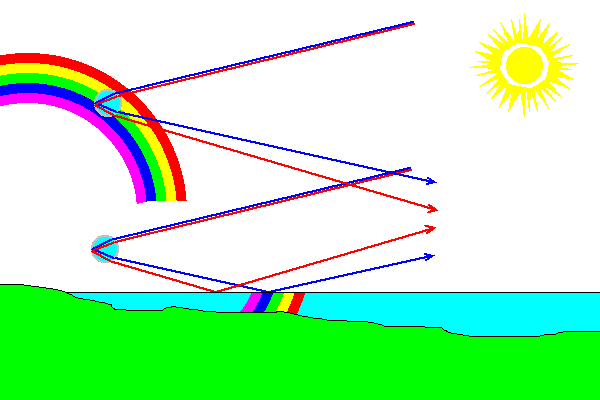
A rainbow isn't a physically real object, merely a cone of drops that refracts light back to our eyes at a particular angle. Nevertheless, it's possible to see rainbows reflected in water under the right conditions. How can that be?
The answer is that it's different drops that produce the reflected rainbow. These drops refract light on a path that would normally miss you completely, except that it's reflected to your eye.
Secondary (and Higher?) Rainbows
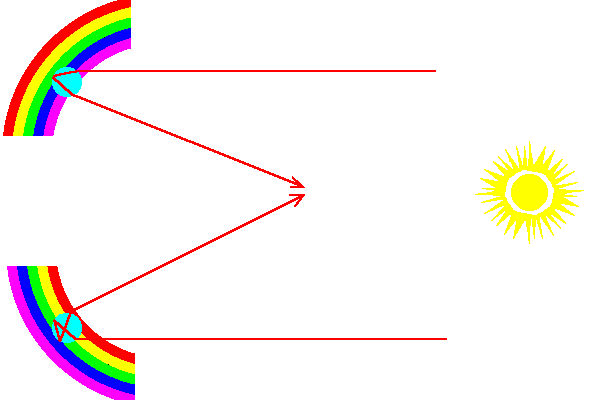
We often see double rainbows, with a fainter bow outside the primary bow and its colors reversed. The secondary bow is formed by light reflected twice within the drops, and is always fainter. After all, any light that exits to form the primary bow is no longer available to form a secondary bow.
The fact that the two bows are close together is misleading. Actually, the right side of the primary bow corresponds to the left side of the secondary, and vice versa. That's why the colors are reversed.
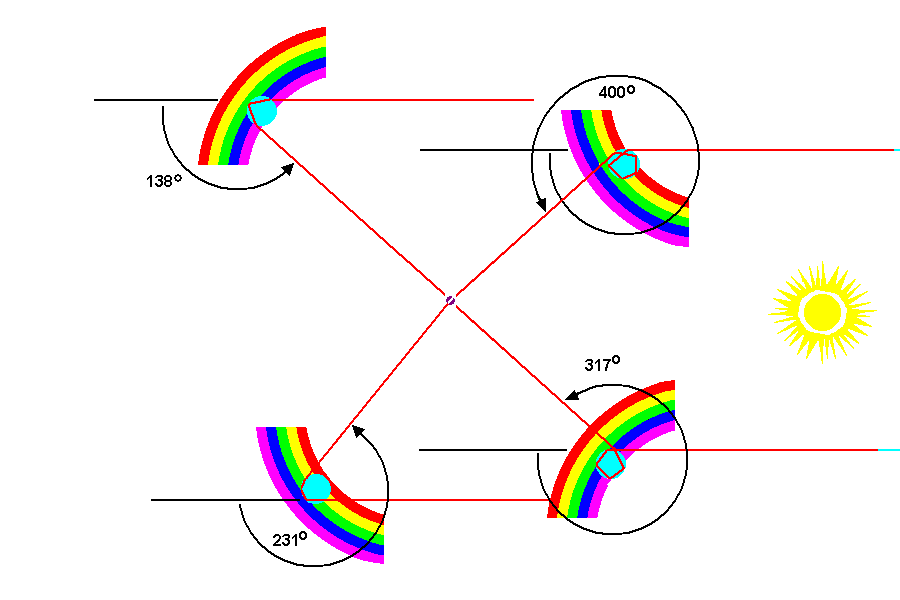
So is it possible to see a third order or tertiary rainbow? The surprising answer is that the tertiary bow wouldn't be just outside the secondary bow as you'd expect, but back in the direction of the sun. Light from the primary bow gets bent through 137.5 degrees, light from the secondary bow gets bent 231 degrees. Since we look opposite the sun (180 degrees away) to see a rainbow, the primary bow has a radius of 180 - 137.5 = 42.5 degrees and the secondary bow has a radius of 231 - 180 = 51 degrees. That's why they appear close together. Light from the tertiary bow gets bent 317.5 degrees, so the bow is only 42.5 degrees from the sun. It's in a completely different part of the sky.
To see a tertiary bow, you'd have to be looking through rain toward the sun, and there's a lot of glare in that direction. I've tried on several occasions without success. There are a few claimed sightings but no photographs. To make matters worse, the fourth order bow overlaps the third order bow but with reversed colors, meaning anything you do see will be washed out.
High order "rainbows" can be observed in the lab. Not the entire bow, but rays of light that have been internally reflected many times. A drop of water and a laser will do it.
Fogbows and Cloud Bows
In principle, water droplets in clouds should produce rainbows. In practice, when particles are very tiny, light experiences a process called diffraction that produces colored halos around each droplet. These colored halos smear out any rainbow colors, so all you can see is a diffuse white arc.
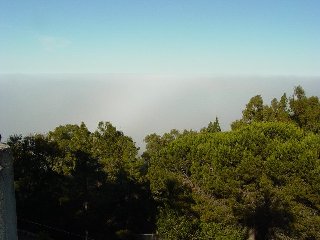 |
At left center is a fogbow on distant low clouds. The arc is sharply defined but lacks color. The nearest part of the fog bank is maybe half a mile away, but the horizon is many miles away. Nevertheless, the bow extends right to the horizon. |
Coronas
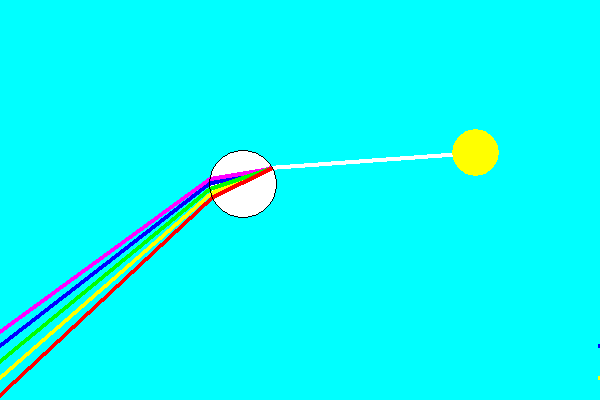
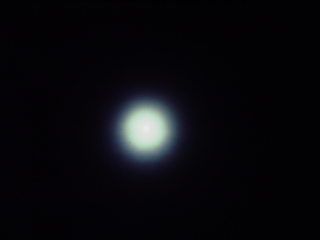 |
Coronas are fairly simple. They are colored rings around the sun or moon, caused when water droplets or ice crystals refract light passing through them. The bend angle isn't large so the colors are always very close to the sun or moon. |
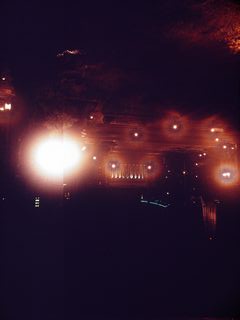 |
The droplets don't have to be far away to create the effect. A fogged up window pane will do it nicely. |
Ice Halos
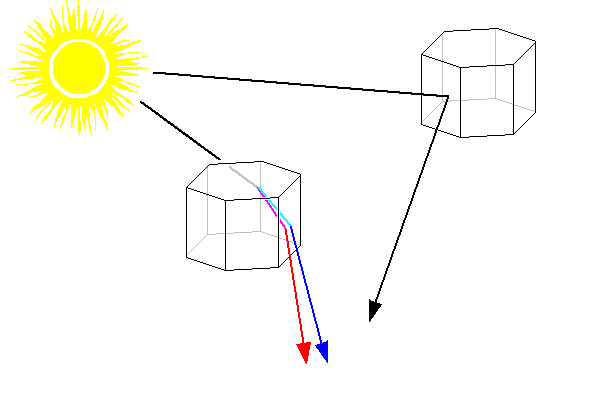
Ice can both reflect and refract light and the range of optical effects produced by ice is enormous. Ice crystals can vary in shape and can produce special effects if the air is still and the ice crystals have some specific orientation. Some of the more common effects are shown below. Halos are due to refraction through the ice crystals. Sun pillars and parhelic circles are due to reflection off vertical and horizontal faces of the ice crystals. These appear when the air is calm because any turbulence would cause the ice crystals to be randomly oriented.
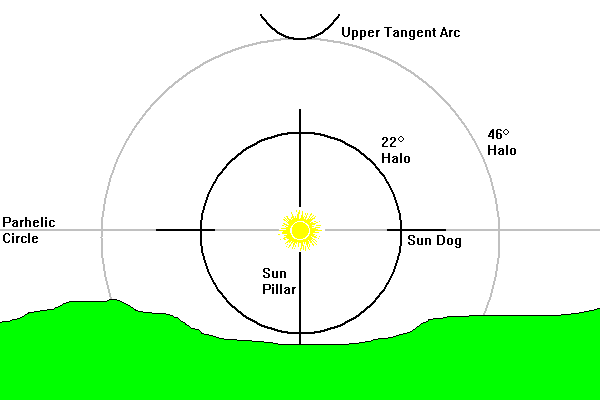
 |
This picture, tinted green by window glass, shows a 22 degree halo and a rarely seen small halo. The cause of the small halo is not certain but may be due to unusual crystalline forms of ice that form at extremely low temperatures. |
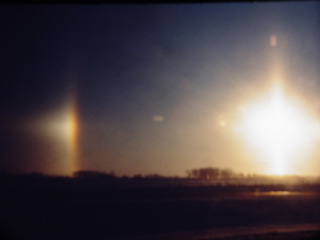 |
Here we have a very intense 22 degree halo and sun dog plus a sun pillar. These are due to wind-blown snow and thus end not far above the horizon. |
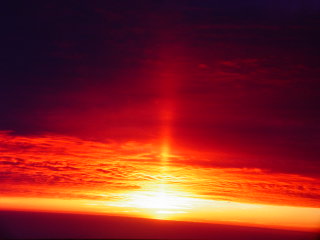 |
A spectacular sun pillar seen from an aircraft. |
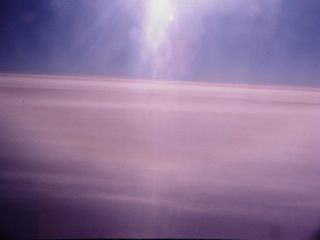 |
Flying above a cirrus cloud layer may present the opportunity to observe a halo in the clouds below. |
 |
Sometimes, thin cirrus layers below your plane will have ice crystals all with similar orientations that reflect the sun like a mirror. Sometimes an anti-sun will be so bright it can even have its own sundogs. |
The Glory
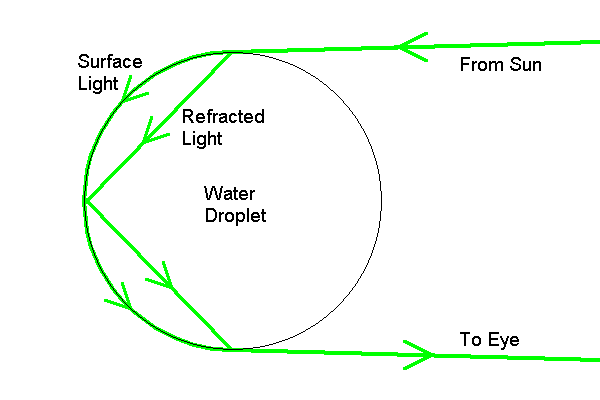
Air travelers commonly see the shadow of their airplane surrounded by colored rings. This phenomenon, the glory, is fairly complex. When light hits a water droplet at a grazing angle, some of it is refracted into the droplet and some travels along the surface. The refracted light bounces off the back of the droplet and exits on the other side, where it encounters the light traveling along the surface. If the light waves are in step, they add up (called constructive interference). Other waves are out of step and cancel out (called destructive interference). The wavelengths that experience constructive interference show up as colored rings.
We can see from this that:
- Glories only occur in water droplet clouds. If you see one, you know the clouds are made up of water droplets. They are most often seen during takeoffs and landings.
- They depend on the size of the droplets so are quite variable.
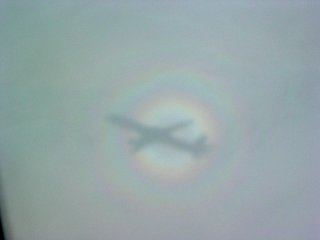 |
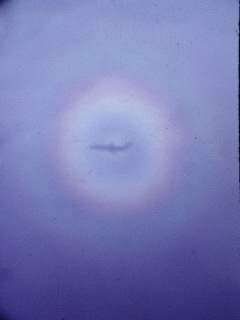 |
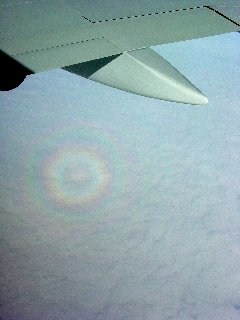 |
If your plane is far from the clouds, it no longer casts a shadow. As seen from the clouds, your plane is silhouetted against the sun, but doesn't cover it. Nevertheless, the glory still appears as a series of colored rings. |
 |
In this photo, the glory appears under the wing near the left edge and a faint cloud bow appears extending vertically below the rightmost wing pod. |
Before air travel, the only way to see this effect was to be on a mountain peak with the sun casting your shadow onto clouds. It was rarely seen. If a group of people observed this effect, each person saw the glory around his own shadow. Some people think the haloes in religious art were inspired by this effect. A mountain in Germany, the Brocken, is a place where this effect occurs frequently because of its foggy weather, and the combination of the observer's shadow and glory is sometimes called the Specter of the Brocken.
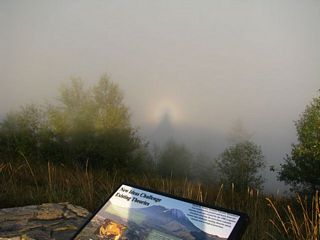 |
It sounds simple but the Specter of the Brocken is rarely seen. You need bright sun behind you and thick fog in front. This is the only time in my life I have ever photographed it. |
Volcanic Effects
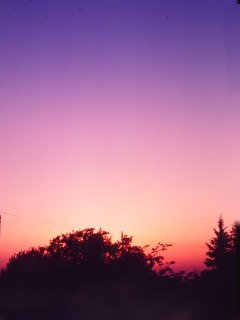 |
Large volcanic eruptions eject large amounts of sulfuric acid droplets into the stratosphere. These photos were all taken after the great eruption of Mount Pinatubo in 1991, although smaller eruptions can produce short episodes of these effects. One effect is long-lasting sunset colors extending high into the sky. Often the colors are light purple, so this effect is called the purple light. |
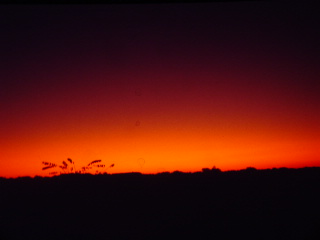 |
Intense sunset colors can persist long after sunset. |
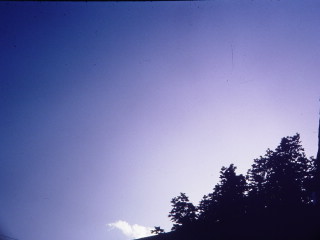 |
Bright glare around the sun often grades into the blue sky in a diffuse purplish or brownish halo, called Bishop's Ring. |
Return to Earth Science Notes Index
Return to Physical Geology Notes Index
Access Slides on Coastal Erosion
Return to Professor Dutch's Home Page
Created 21 May 1997, Last Update 4 May 2000